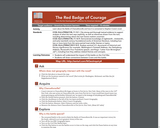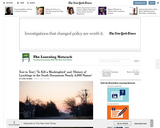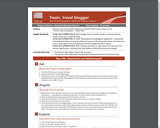
Learn about the Battle of Chancellorsville and how it is connected to Stephen Crane’s novel.
- Subject:
- English Language Arts
- Material Type:
- Activity/Lab
- Author:
- ESRI
- Date Added:
- 04/11/2020

Learn about the Battle of Chancellorsville and how it is connected to Stephen Crane’s novel.

In this lesson plan, students will identify six types of rhetoric in the provided examples (handout included), as well as practice incorporating such devices into their own writing.

This lesson is designed to apply Common Core State Standards and facilitate a comparison of informational texts and primary source material from the Scottsboro Boys trials of the 1931 and 1933, and the fictional trial in Harper Lee's novel, To Kill A Mockingbird (1960).

Students are presented with a paired critical reading activity uses excertps from Harper Lee's To Kill a Mockingbird and a New York Times article "˜History of Lynchings in the South Documents Nearly 4,000 Names"™ to exlplore the deep and painful history of racial injustice in the south. Included are close fiction/non-fiction analysis, varied media resources, and writing assignments.

In this resource from the New York Times, a paired critical reading activity uses excertps from Harper Lee's To Kill a Mockingbird and a New York Times article ‘History of Lynchings in the South Documents Nearly 4,000 Names’ to exlplore the deep and painful history of racial injustice in the south. Included are close fiction/non-fiction analysis, varied media resources, and writing assignments.

Discover how travel and life experiences influenced Mark Twain’s body of work.
“Travel is fatal to prejudice.” – Mark Twain

This resource focusing on the rhetorical situation of the "March on Washington" is based on a template that teachers can use to create Inquiry Based Research Lessons and Units. It is a hyperdoc template that is based on the eWISE Research Model. It is broken into the 4 stages of the research model (Wonder, Investigate, Synthesize and Express).
.